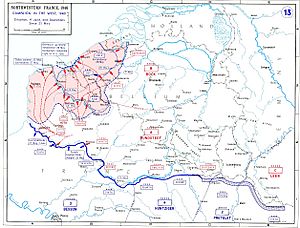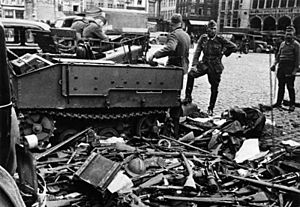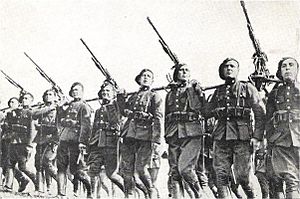Battle of the Lys (1940) facts for kids
Quick facts for kids Battle of the Lys |
|||||||
|---|---|---|---|---|---|---|---|
| Part of the Invasion of Belgium of World War II | |||||||
 Final Defensive Positions of the Allies along the Lys River |
|||||||
|
|||||||
| Belligerents | |||||||
| Commanders and leaders | |||||||
| Strength | |||||||
| 500,000 | 12 divisions | ||||||
| Casualties and losses | |||||||
| 40,000+ casualties | unknown 320–400+ captured |
||||||
The Battle of the Lys was a really important fight between Belgian and German soldiers during World War II in 1940. It was the last big battle the Belgian army fought before they had to surrender on May 28. This battle was the toughest and bloodiest part of the 18-day fight in Belgium. The battle is named after the Leie River, also known as the Lys, where the fighting happened.
Contents
The Battle Begins
First Fights
On May 24, 1940, German forces launched a strong attack. This forced the Allied troops to fall back. They moved across the Lys River near Kortrijk. The 1st and 3rd Belgian divisions were there. The Belgians had agreed to leave the Scheldt area. This was to help British troops prepare for a counter-attack. However, it didn't really help the overall situation much.
The Allied line faced four German divisions. So, the 9th and 10th Belgian Divisions quickly came to help. The Belgian II Army Corps even launched a counter-attack. They managed to capture 200 German soldiers.
Belgian artillery fired effectively at the Germans. But Allied lines were bombed and shot at from the air a lot. They had very little air support of their own. A German division from Menen moved towards Ypres. This threatened to cut off the Belgian Army from the British. The Belgians' 2nd Cavalry Brigade and 6th Infantry Division came to support the area. They managed to stop the Germans for a while.
British Retreat and Belgian Stand
By May 25, the British realized that more counter-attacks were not possible. They began to pull back towards the port of Dunkirk. All hope of saving the Belgian Army was lost. It became clear that the Belgians could only try to buy time. This time was needed for the Allies to evacuate. The British sent a brigade and a machine gun battalion to help. These were their only remaining reserve troops.
At 6:30 AM, the 12th Royal Lancers, an armored car group, was sent north of the Lys. Their job was to cover the left side of the British 2nd Army Corps. They also needed to reconnect with the Belgians there. The regiment reported that the Belgians were retreating. They were facing much stronger German forces. The British also fought the Germans now and then.
On that day, King Leopold III told his troops, "Whatever may happen, I shall share your fate." Some parts of the Belgian 5th and 17th regiments had very low morale. They surrendered a bridgehead at Meigem without a fight. This went against their officers' orders. The special Chasseurs Ardennais soldiers were sent to the small village of Vinkt. Here, their 1st Division successfully fought off many attacks. These attacks were from Germany's 56th Infantry Division.
Lieutenant Colonel George Davy, who was with the Belgian Army Headquarters, learned that the Belgians could not spread their forces any further. That night, 2,000 wagons were placed side by side. They lined the rail line from Roeselare to Ypres. This was an attempt to create a barrier against tanks.
Belgian Position Worsens
By May 26, the Allied situation was becoming very difficult. The Belgians were struggling to hold Izegem, Nevele, and Ronsele. The Chasseurs Ardennais continued to hold their ground against the 56th German division. This German division was later replaced by the 225th Infantry Division.
The German 256th Infantry Division managed to cross a canal at Balgerhoeck. They then attacked Eeklo. The Belgian Lanciers Regiment left Passchendaele and Zonnebeke. British engineers blew up the Menin Gate bridge. New German units threatened to split the Belgian and British lines. But a Belgian infantry division and a cavalry division stopped their attack. Another infantry division kept the defensive line strong.
All of Belgium's reserve troops were now fighting. Even auxiliary troops started using 75mm guns from training centers to form a rear defense. The Belgian Command began to flood the canals. This was to try and stop the Germans. At midday, the Belgian Army told General Pierre Champon, a French general, that "the Army has nearly reached the limits of its endurance."
At 6:00 PM, French General Georges Blanchard arrived. He told Leopold that the British were pulling back even further. They were moving to the Lille-Ypres line. Lord Gort ordered Major General Harold Franklyn to defend the dry Comines-Ypres Canal. His 5th Infantry Division would cover the retreat towards Dunkirk. That evening, Leopold started planning to move his headquarters to Middelkerke.
The End of the Battle
Near Collapse and Surrender
The Belgian Army began to fall apart on May 27. The railways were not working. The roads were blocked with 1.5 million refugees. This was in addition to the 800,000 people already living there. Ammunition and food were running low. There were no fresh troops available. The Belgians started destroying their artillery as they ran out of ammunition and retreated.
By 11:00 AM, the defense line had been broken. This happened north of Maldegem, in the center near Ursel, and to the right near Thielt and Roeselare. Bruges was the only major Belgian city not yet taken by the Germans. At 4:00 PM, the Chasseurs Ardennais had to leave Vinkt. This meant the Germans were now in control. The Chasseurs Ardennais had lost 39 men but had killed 170 Germans. Sadly, in the Vinkt massacre that followed, many civilians in the village were killed by vengeful German troops. However, a counter-attack by the 4th Carabiners Cyclists at Knesselaere captured 120–200 German prisoners.
Around the same time, the Belgian Command understood two main things:
- The Belgian Army had done its job. It had fought as hard as it could. Its units could not keep fighting. Retreating further would destroy the units more than the current fighting. It would also make the Allied forces even more crowded.
- Sending someone to ask for peace terms would give the Allies time. They would have the night of May 27–28 and part of the morning of May 28. If the fighting continued, this time could only be gained by completely destroying the Belgian Army.

The Belgian army's chief of staff, Lieutenant General Oscar Michiels, suggested sending a representative to the Germans. This person would ask for a ceasefire. At 5:00 PM, Leopold decided to send Major General Olivier Derousseaux to the headquarters of the German 18th Army. Two French Army divisions were moved by truck towards Dunkirk. Belgian flags and battle standards were hidden to keep them safe. A final order to retreat was given from the Belgian Army headquarters at 8:00 PM.
General Derousseaux returned at 10:00 PM with the answer: "The Führer demands that arms be laid down unconditionally." King Leopold was disappointed but knew the Belgian Army had no other choice. At 11:00 PM, with his staff's full support, he accepted the demand. He agreed to a ceasefire at 4:00 AM the next day.
The Belgians put down their weapons at 4:00 AM on May 28. Fighting continued at the Roeselare-Ypres line until 6:00 AM. That's when the troops there finally received the order to surrender. Leopold made one last message to his soldiers:
"You were suddenly thrown into a war of incredible violence. You fought bravely to defend your homeland step by step. You are exhausted from fighting non-stop against an enemy with many more soldiers and equipment. We have been forced to surrender. History will show that the Army did its duty completely. Our honor is safe. This tough fighting, these sleepless nights, cannot have been for nothing. I ask you not to lose heart. Carry yourselves with dignity. Let your behavior and discipline continue to earn you the respect of others. I will not leave you in our misfortune. I will watch over your future and that of your families. Tomorrow we will start working with the strong goal of rebuilding our country from its ruins."
Aftermath
Even though the Belgians tried to delay the Germans as long as possible, their surrender made the Allies angry. The Allies' armies now had their north-western side open to German attack. French civilians also became more unfriendly towards Belgians around them.
The Battle of the Lys was one of the bloodiest parts of the Belgian campaign. Out of Belgium's 80,000 casualties during the invasion, 40,000 happened between May 25 and 27.
On May 30, General Michiels gave a speech to all the senior Belgian officers. He thanked them for their service.
Leopold's choice to stay with his army and surrender was seen as disloyal by Hubert Pierlot and the Belgian government in exile. After the war, public questions about his loyalty led to the Royal Question. In the end, Leopold gave up his throne to his son.
Commemoration
In the Albertpark, in the center of Kortrijk, the Battle of the Lys is remembered every year. This happens near the city's Monument of the Lys.
See also
- Manstein Plan
Sources




